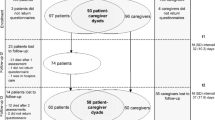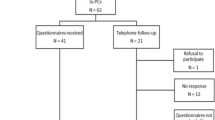Abstract
Goal of work
Research on global quality of life (GQOL) in primary caregivers (PCGs) of cancer patients is limited. This study measured significant domains of GQOL in PCGs and their association with the patients’ disease trajectory and the PCGs’ background and life situation. This study also explored differences in their GQOL compared to a normative sample from the general population (NORM).
Patient and methods
In a cross-sectional design, 71 PCGs (aged ≥50 years) of cancer patients in palliative phase rated their GQOL by the Quality of Life Scale (QOLS) and provided information concerning demography, experienced social support, and caring situation. Associations between the QOLS scores and variables of the patients’ medical history were assessed, and comparisons of QOLS scores were made between the PCGs and age- and gender-adjusted NORM.
Main results
Long duration of the curative phase for patients and holding a job for PCGs were significantly associated with a favorable GQOL in PCGs. The mean total GQOL score did not differ significantly between the PCGs and NORM groups, though subanalyses revealed significantly more favorable mean score of the relational domain in PCGs compared to NORM.
Conclusions
GQOL in PCGs of cancer patients in palliative phase staying at home was as good as that of the NORM. For PCGs not employed or caring for patients with a short curative phase, getting some recreation could be of importance for improvement of GQOL.


Similar content being viewed by others
References
Aaronson NK, Cull AM, Kaasa S, Sprangers MAG (1996) The European organization for research and treatment of cancer (EORTC) modular approach to quality of life assessment in oncology: an update. In: Spilker B (ed) Quality of life and pharmacoeconomics in clinical trials, 2nd edn. Lippincott-Raven, Philadelphia 179–189
Andershed B, Ternestedt BM (1998) Involvement of relatives in the care of the dying in different care cultures: involvement in the dark or in the light? Cancer Nurs 21:106–116
Anderson KL (1995) The effect of chronic obstructive pulmonary disease on quality of life. Res Nurs Health 18:547–556
Bo K, Talseth T, Vinsnes A (2000) Randomized controlled trial on the effect of pelvic floor muscle training on quality of life and sexual problems in genuine stress incontinent women. Acta Obstet Gynecol Scand 79:598–603
Burckhardt CS, Anderson KL, Archenholtz B, Hagg O (2003) The Flanagan quality of life Scale: evidence of construct validity. Health Qual Life Outcomes 1:59
Burckhardt CS, Archenholtz B, Bjelle A (1992) Measuring the quality of life of women with rheumatoid arthritis or systemic lupus erythematosus: a Swedish version of the quality of life scale (QOLS). Scand J Rheumatol 21:190–195
Burckhardt CS, Woods SL, Schultz AA, Ziebarth DM (1989) Quality of life of adults with chronic illness: a psychometric study. Res Nurs Health 12:347–354
Charlton R (2002) Primary palliative care. Radcliffe Medical, Oxon, UK
de Meneses MR, Burgess Perry GR (1993) The plight of caregivers. Home Healthc Nurse 11:10–14
Fayers P, Machin D (2000) Quality of life. Wiley, Chichester, UK
Given BA, Given CW, Kozachik S (2001) Family support in advanced cancer. CA Cancer J Clin 51:213–231
Glajchen M (2004) The emerging role and needs of family caregivers in cancer care. J Support Oncol 2:145–155
Grov EK (1999) Død hjemme: hvordan kan sykepleieren bidra til å fremme mulighet for personer med langtkommen kreft til å dø hjemme? (Death at home—how can the nurse contribute in making palliative phase and death at home possible for people with terminal cancer?) Vard Nord 19:4–9
Grov EK, Dahl AA, Moum T, Fossa SD (2005) Anxiety, depression, and quality of life in caregivers of patients with cancer in late palliative phase. Ann Oncol 16:1185–1191
Grov EK, Fosså SD, Tønnessen A, Dahl AA (2005) The caregiver reaction assessment: psychometrics, and temporal stability in primary caregivers of Norwegian cancer patients in late palliative phase. Psycho Oncol (in press)
Grunfeld E, Coyle D, Whelan T, Clinch J, Reyno L, Earle CC, Willan A, Viola R, Coristine M, Janz T, Glossop R (2004) Family caregiver burden: results of a longitudinal study of breast cancer patients and their principal caregivers. CMAJ. 170:1795–1801
Harrington V, Lackey NR, Gates MF (1996) Needs of caregivers of clinic and hospice cancer patients. Cancer Nurs 19:118–125
Hjermstad MJ, Fossa SD, Bjordal K, Kaasa S (1995) Test/retest study of the European organization for research and treatment of cancer core quality-of-life questionnaire. J Clin Oncol 13:1249–1254
Hoffmann RL Mitchell AM (1998) Caregiver burden: historical development. Nurs Forum 33:5–11
Hull, MM (1989) A family experience: Hospice supported home care of a dying relative. UMI, University Microfilms International
Jordhoy MS, Kaasa S, Fayers P, Ovreness T, Underland G, Ahlner-Elmqvist M (1999) Challenges in palliative care research; recruitment, attrition and compliance: experience from a randomized controlled trial. Palliat Med 13:299–310
Motzer SU, Stewart BJ (1996) Sense of coherence as a predictor of quality of life in persons with coronary heart disease surviving cardiac arrest. Res Nurs Health 19:287–298
Ruperto N, Ravelli A, Levinson JE, Shear ES, Murray K, Link TB, Martini A, Glass DN, Giannini EH (1997) Long-term health outcomes and quality of life in American and Italian inception cohorts of patients with juvenile rheumatoid arthritis. II. Early predictors of outcome. J Rheumatol 24:952–958
Schwartz C, Meisenhelder JB, Ma Y, Reed G (2003) Altruistic social interest behaviors are associated with better mental health. Psychosom Med 65:778–785
Schwartz CE, Sprangers MA (1999) Methodological approaches for assessing response shift in longitudinal health-related quality-of-life research. Soc Sci Med 48:1531–1548
Sherman DW, McSherry CB, Parkas V, Ye XY, Calabrese M, Gatto M (2005) Recruitment and retention in a longitudinal palliative care study. Appl Nurs Res 18:167–177
Soothill K, Morris SM, Harman JC, Francis B, Thomas C, McIllmurray MB (2001) Informal carers of cancer patients: what are their unmet psychosocial needs? Health Soc Care Community 9:464–475
Spilker B (1996) Quality of life and pharmacoeconomics in clinical trials. Lippincott Williams & Wilkins, Philadelphia, USA
Sprangers MA, Schwartz CE (1999) Integrating response shift into health-related quality of life research: a theoretical model. Soc Sci Med 48:1507–1515
Stromgren AS, Sjogren P, Goldschmidt D, Petersen MA, Pedersen L, Hoermann L, Groenvold M (2005) A longitudinal study of palliative care: patient-evaluated outcome and impact of attrition. Cancer 103:1747–1755
Toseland RW, Blanchard CG, McCallion P (1995) A problem solving intervention for caregivers of cancer patients. Soc Sci Med 40:517–528
Wahl A, Burckhardt C, Wiklund I, Hanestad BR (1998) The Norwegian version of the quality of life scale (QOLS-N). A validation and reliability study in patients suffering from psoriasis. Scand J Caring Sci 12:215–222
Wahl A, Loge JH, Wiklund I, Hanestad BR (2000) The burden of psoriasis: a study concerning health-related quality of life among Norwegian adult patients with psoriasis compared with general population norms. J Am Acad Dermatol 43:803–808
Wahl AK, Rustoen T, Hanestad BR, Lerdal A, Moum T (2004) Quality of life in the general Norwegian population, measured by the quality of life scale (QOLS-N). Qual Life Res 13:1001–1009
Weitzner MA, McMillan SC (1999) The caregiver quality of life index-cancer (CQOLC) scale: revalidation in a home hospice setting. J Palliat Care 15:13–20
Weitzner MA, McMillan SC, Jacobsen PB (1999) Family caregiver quality of life: differences between curative and palliative cancer treatment settings. J Pain Symptom Manage 17:418–428
Acknowledgement
This project is funded by a research career grant to Ellen Karine Grov from Buskerud University College, Norway, Grant # 24013.
Author information
Authors and Affiliations
Corresponding author
Rights and permissions
About this article
Cite this article
Grov, E.K., Dahl, A.A., Fosså, S.D. et al. Global quality of life in primary caregivers of patients with cancer in palliative phase staying at home. Support Care Cancer 14, 943–951 (2006). https://doi.org/10.1007/s00520-006-0026-9
Received:
Accepted:
Published:
Issue Date:
DOI: https://doi.org/10.1007/s00520-006-0026-9




